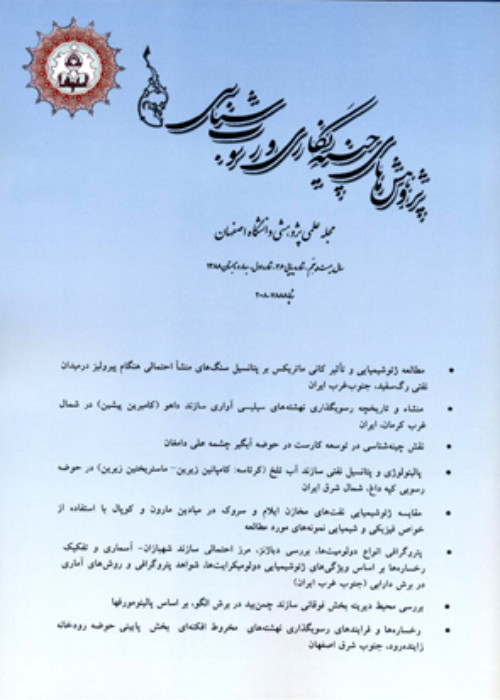Microbiostratigraphy of the Jahrum Formation in Nimbashi section, West Estahban, Fars
Author(s):
Article Type:
Research/Original Article (دارای رتبه معتبر)
Abstract:
Introduction
Zagros sedimentary basin in the south and southwest of Iran holds oil and gas huge reservoirs. This basin which bordered the closure of the Paleotethys ocean (Berberian and King 1981), with high thickness of sedimentary sequences laid down in the Mesozoic and Cenozoic. The Jahrum Formation is carbonate sequence that has deposited during the Paleocene–Eocene series (Motiei 1993) and is the carbonate reservoirs rock of the same age in the Zagros sedimentary basin. This research investigates the sedimentary sequence of the Jahrum Formation in TangNimbashi section, to reach the purposes of biostratigraphy, determination of relative age and compare with other sections. This stratigraphic section was measured in detail at 29° 07' 49" N and 53° 55' 30" E and is located in northern flank of Tudej (Toudaj) anticline (west Estahban, Fars province), in the Interior Fars subzone, Fars sub-basin and Zagros simply folded belt.
Material & Methods
Includes five stages: a) survey and recording geographic coordinates with global positioning system (GPS) and recognition of the lower and upper boundaries. b) Measuring of the degree and direction of dip (32˚SW) and strike (N85˚W) of layers with compass and determining the direction of the travelling angle (N5˚E). c) Measuring the true thickness of the strata perpendicular to their strike by Jacob Staff and numbering of beds. d) Field description (lithology, stratification, color, fossils) and photography of outcrops. e) Systematic sampling at intervals of two meters and sometimes one meter. Finally the stratigraphic section was measured 628 meters and 338 rock samples were collected and also 153 photos were taken. Then thin sections were evaluated and photographed with binocular microscope in plane polarized light (PPL). Also, different references were used to identify the genus and species of microfossils: (Rahaghi 1980; Loeblich and Tappan 1988; Vecchio et al. 2007; Hottinger 2007 & 2014; Boudagher-Fadel 2008 & 2018; Ozgen-Erdem 2008; Sirel 2009; Di Carlo et al. 2010; Alan 2011; Salih 2012; Molina et al. 2013; Zhang et al. 2013; Deveciler 2014; Bukhari et al. 2016).
Discussion of Results & Conclusions
The Jahrum Formation with dolostone, dolomitic limestone and limestone units and medium to very thick stratification, has been deposited on the low-rise, foothills, limestone and marly limestone units of Sachun Formation with very thin to medium stratification. Due to the lack of a detritus unit and paleosol this boundary is sharp, homocline and probably conformable. Its upper boundary after two steps of gradual change and conversion, homocline and conformable its own longer and bladed units to low-rise and foothills units in 505-553.5, 553.5?-575.5? and 575.5-593 meters of the Pabdeh Formation, finally this formation (Jahrum Formation) is covered by Quaternary poorly consolidated alluvial deposits. So, it is impossible to get exact and certain conclusions about this boundary, now. In fact, based on field studies, petrography, microfacies, and microbiostratigraphy, it seems that inthe thicknesses mentioned above, the Jahrom and Pabdeh formations have become interfingering or intertonguing (Pinch-out) each other. With detailed field and laboratory examinations on outcrops and thin sections from the bottom to the top of the Jahrom Formation has been includes 7 lithostratigraphic units (J.1-J.7) and the Pabdeh Formation has been includes 2 lithostratigraphic units (P.1&P.2). Based on identification of 34 genus and 29 species of benthic foraminifera, and 7 genus and 1 species of planktonic foraminifera and according to their pattern of dispersal 13 zonations were recognized. In order 9 assemblage biozones, 2 barren intrazones, 1 barren interzone and 1 indeterminate zone (not well determined). Separated assemblage biozones with biozonation of the benthic foraminifera of the Paleogene sub-system in Zagros basin was suggested by Wynd (1965) and Adams and Bourgeois (1967), also with biozonation of the shallow larger benthic foraminifera (SLBF) of the Tethys basin was proposed by Serra-Kiel et al., 1998, were compared and then their age was determined. The relative age of the Jahrum Formation in this section from 0–20 meters not well determined because of processes of dolomitizatoin, recrystallization, diagenesis and finally absence of index microfossils (foraminifers). But the relative age is estimated from 20 to 143 meters: Late Paleocene? to Early Eocene series (Late Thanetian? –Ilerdian) and from 143–628 meters: Middle Eocene series (Lutetian–Bartonian). This age is suggested with 7 assemblage biozones, including: Alveolina ellipsoidalis-Orbitolites spp. assemblage biozone, Dictyoconus-Coskinolina-Haymanella assemblage biozones (this assemblage has three assemblage sub-biozones: Alveolina-Haymanella-Medocia, Dictyoconus-Coskinolina-Alveolina and Dictyoconus-Coskinolina-Haymanella), Somalina-Medocia assemblage biozone, Nummulites-Alveolina assemblage biozone, Linderina assemblage biozone, that is comparable with assemblage zone 43 and assemblage subzones 44, 48, 49, 50 and 51 (Wynd 1965), Coskinolina sp.-Rhapydionina sp. assemblage zone (Adams and Bourgeois 1967) and also shallow benthic zones (SBZ.) 6, 13, 14 and 17 (Serra-Kiel et al. 1988).Keywords:
Language:
Persian
Published:
Stratigraphy and Sedimentology Researches, Volume:34 Issue: 3, 2018
Pages:
73 to 94
magiran.com/p1970906
دانلود و مطالعه متن این مقاله با یکی از روشهای زیر امکان پذیر است:
اشتراک شخصی
با عضویت و پرداخت آنلاین حق اشتراک یکساله به مبلغ 1,390,000ريال میتوانید 70 عنوان مطلب دانلود کنید!
اشتراک سازمانی
به کتابخانه دانشگاه یا محل کار خود پیشنهاد کنید تا اشتراک سازمانی این پایگاه را برای دسترسی نامحدود همه کاربران به متن مطالب تهیه نمایند!
توجه!
- حق عضویت دریافتی صرف حمایت از نشریات عضو و نگهداری، تکمیل و توسعه مگیران میشود.
- پرداخت حق اشتراک و دانلود مقالات اجازه بازنشر آن در سایر رسانههای چاپی و دیجیتال را به کاربر نمیدهد.
In order to view content subscription is required
Personal subscription
Subscribe magiran.com for 70 € euros via PayPal and download 70 articles during a year.
Organization subscription
Please contact us to subscribe your university or library for unlimited access!


